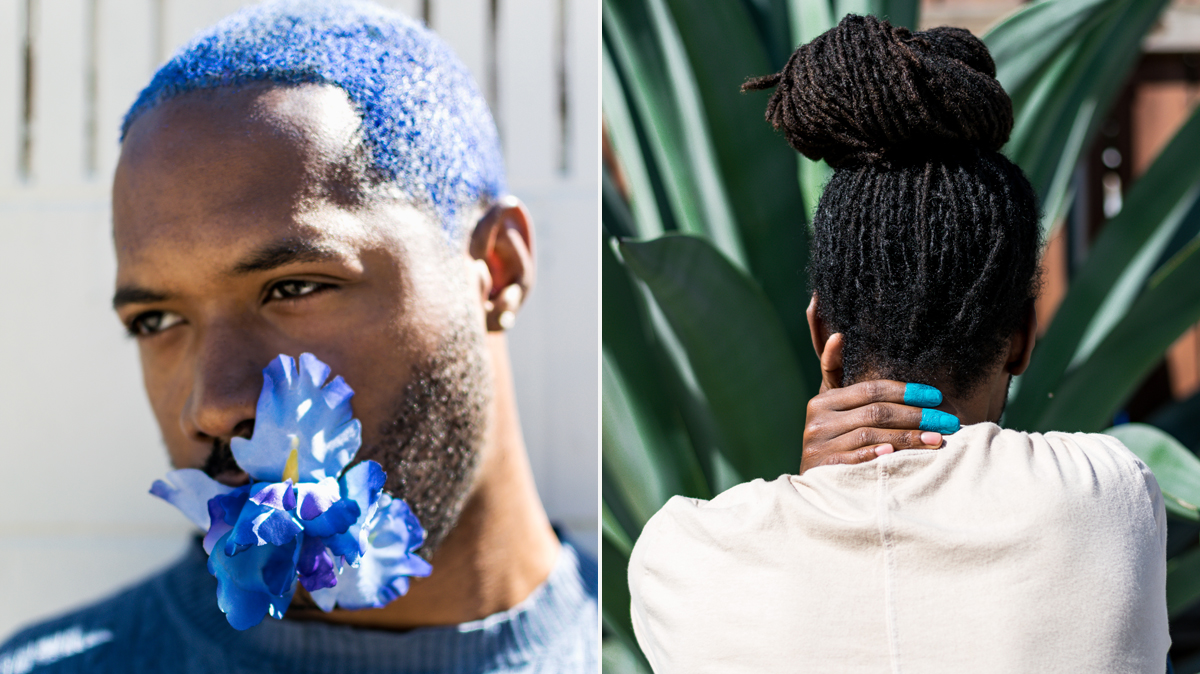The “Disposable Series” Makes Room for Queer Artists Of Color
We speak with the minds behind the collective that showcases less represented communities

by Kyle Raymond Fitzpatrick
For Travis Geter, Robert Vance, and Redgi Woods, the art world was not a place that they saw themselves represented within. The queer men—who work as a photographer, creative director, and art director respectively—repeatedly felt that the stories and the work of queer people of color were markedly absent from gallery walls, and they were tired of it. In response—and in critique—of this problem, they’ve taken matters into their own hands, forming the creative collective The Good Friend Brand to explore these subjects. Their first entry, “The Disposable Series” featuring Geter’s “Shades Project” is an introduction to what they hope to accomplish. Set in a loft in Downtown Los Angeles, the series sets Geter’s photos against different shades of blue and various ephemera of queer men, from denim shirts to small bouquets of flowers. Visitors were able to interact with the project and read about Geter’s subjects, all queer men of color caught in visual dialogue with the color blue. The hope of Geter’s work and the ongoing series is to provide a platform offline for queer artists of color to exalt and amplify the community’s work from within—for everyone to see.
To get a deeper understanding of the project’s scope, we spoke with Geter, Woods, and Vance about the project and how they hope to see it grow.

Where did the idea for “The SHADES Project” come from?
Travis Geter: So there are actually two different ideas here. “The SHADES Project” is a portrait series that I began earlier this year. Basically, I just wanted to show positive images of black men and tell a little of their story. It was my artistic response to all of the injustices that many black men face on a daily basis. But mostly because of the many innocent black lives that were taken last year by police officers.
It’s funny how you can find inspiration almost anywhere. I was listening to music one day and the album artwork was a blue color palette. Then a lightbulb went off. Long story short, I eventually came to the idea of comparing the different shades of blue to the complexities and different “shades” of the black man. “Shades” refers to international background, profession, age, sexuality, physical build, and personal identity.
As a founding member of The Good Friend Brand, we created “The Disposable Series” to showcase queer artists of color, like myself. Each month, a different artist will have an opportunity to show their work in a gallery setting and have a moderated discussion about the art and social issues over a family style brunch.

What was the photographic process behind your series?
TG: I have a lot of really cool and interesting friends with great stories, so a number of the subjects are people I already know. Others are people I follow or stumble upon on social media that I felt were interesting. I’ve posted ads on Craigslist looking for specific subjects such as twins, surfers, etc. The shoots are all pretty different and mostly on location. I like to use the background as part of the story. I also like to take the subject out of their usual surroundings.

Why is it important that more queer artists of color—and people of color in general—be seen more often in gallery settings?
Redgi Woods: Last February, I had the opportunity to travel abroad and in doing so visited hella art exhibits and museums from a multitude of subjects. I noticed that even the art that showcased African/black culture and people weren’t done/created by black people ourselves. It was like we were giving permission to these other cultures to capture our history and present it to the world with their lens. After that, the fire was lit, and I couldn’t wait to present the concept to my good friends for support. It’s important that we see ourselves in every spectrum and part of every process possible because it creates a sense of “me too” amongst us. We are also able to see the beauty is our shared complexities that otherwise seem fleeting.
Simply put, [lack of] readily available resources is a huge reason why there aren’t more queer artist of colors in those platforms. We aren’t equipped or shown examples of this being done as often. Even as we are doing this, it’s all a learning lesson and self taught for the sake and love of art.

How do you hope an event like “The Disposable Series” will reshape and push the art world forward?
TG: As much as many people hate to admit it, the world is still incredibly racist and prejudiced. I, as well as my colleagues, are hoping that this series will begin a different conversation than what’s usually had. There are so many talented artists in LA that go unnoticed because they lack funding and resources. We want to create a safe space and an opportunity for queer folk like ourselves to be seen.

How do you see “The Shades Project” and “The Disposable Series” growing in the future?
Robert Vance: “The Shades Project” is only the beginning. We look forward to the growth of “The Disposable Series” and hope to partner with art galleries, organizations, and corporations that share our passion for art as well as the queer community of color. This series will be succeeded by “The Good Friend” weekly podcast, Group Chat Live—a social networking event series—and SummitQ, a community conference for networking, support, and educational seminars geared toward young adults. We’re excited about programming and the impact it will have in our community.
Event images by Kyle Raymond Fitzpatrick, all others courtesy of Travis Geter












